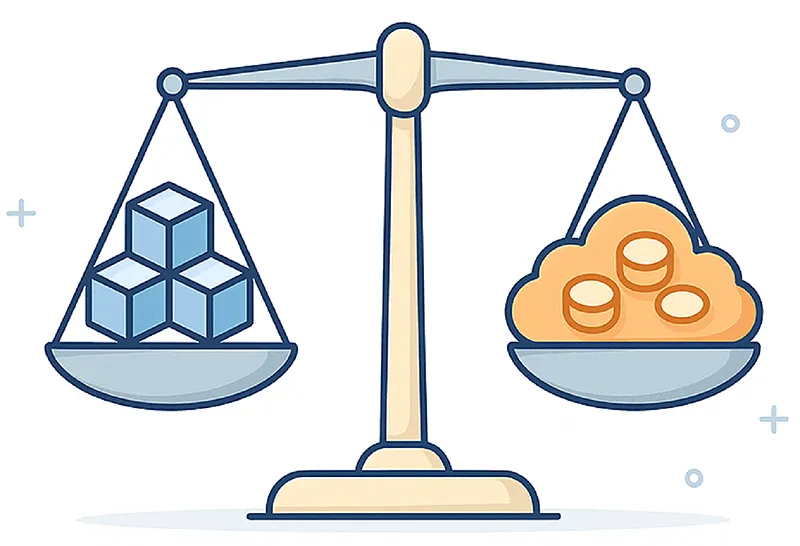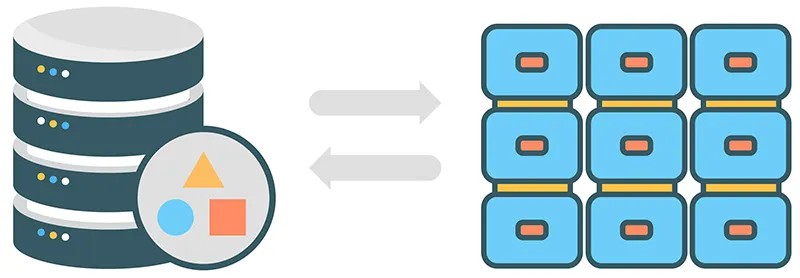Table of contents
- What is block and object storage?
- Exploring storage types: from high-performance blocks to scalable objects
- Advantages and disadvantages
- Features, differences, and choosing the proper storage for your business
- Real-life use cases and examples
- Double Storage — combining block and object storage for ultimate flexibility and data protection
- In conclusion

What is block and object storage?
Block storage and object storage are two of the most widely used cloud storage technologies for businesses today. Both provide scalable ways to store and access data, but they differ in structure, performance, and use cases.
Block storage divides data into small, fixed-size blocks. Each block has a unique identifier and can be stored across multiple storage-based devices for high performance and flexible fast access. This type of storage system is ideal for databases, enterprise applications, or environments running containerized workloads where low latency and fast read/edit/view operations are critical.
Object storage, on the other hand, stores data as discrete units called objects. Each object includes the actual file, its metadata, and a unique ID stored in an object directory table. This object-based storage system is ideal for unstructured data, including backups, videos, logs, and analytics datasets. It’s the foundation of cloud-based object solutions like S3-compatible storage.
Exploring storage types: from high-performance blocks to scalable objects
In practice, both types of storage systems can exist in distributed cloud environments or within fully managed environments running containerized infrastructures.
Block-based storage types include:
Local block storage
Attached directly to physical or virtual machines, it is often used in different operating systems for workloads requiring the fastest access block storage possible. It provides extremely low latency and high throughput since the data resides close to the compute resource, making it ideal for transactional databases or local file storage.
Network block storage
A managed service providing centralized block-level storage that multiple servers can access over a network. This configuration allows for greater flexibility and redundancy — for example, in virtualized infrastructures or clustered environments — ensuring better data protection and scalability.
Cloud block storage
Scalable, cloud-based storage block resources (for instance, AWS EBS) that combine elasticity and high availability. Businesses use it to run production workloads, support migration projects, and maintain high performance for dynamic applications within fully managed environments running containerized workloads.
Object-based storage types include:
Private object storage servers
Deployed on-premises for secure internal use, giving companies complete control over data protection, governance, and access policies. Such object storage systems are ideal for organizations with strict compliance or sovereignty requirements where cloud object storage is not permitted.
Public object storage platforms
Offered by major cloud vendors like AWS S3 or MinIO, these object storage solutions enable massive scalability and fully managed operations. They’re commonly used for archiving, backups, analytics, and object stores, real file repositories where cost efficiency and accessibility are key priorities.
Hybrid or multi-cloud object storage systems
Integrate object storage databases across different providers for improved data protection and resilience. This model allows businesses to combine cloud object scalability with on-premises security, supporting distributed cloud strategies and enabling seamless storage use across various environments.

Advantages and disadvantages
Block storage advantages
High performance and low latency
Block storage provides near-instant access to data at the block level, which makes it ideal for applications where every millisecond matters — from databases to enterprise systems.
Excellent for transactional workloads
Systems that constantly write and update small data pieces, like ERP or financial applications, benefit from the consistent IOPS and throughput that block-based storage systems deliver.
Supports edit, read, and update operations quickly
Since block storage separates data into small chunks, applications can modify only the parts they need, increasing efficiency and minimizing processing overhead.
Works seamlessly with file systems and different operating systems
It easily integrates with file storage layers and can operate across different operating systems, providing a familiar environment for developers and administrators.
Block storage limitations
Complex to manage at scale
As data volumes grow, maintaining multiple block storage systems and replication policies becomes challenging, often requiring specialized tools or automation.
No built-in metadata (must be managed externally)
Unlike object storage systems, blocks don’t carry metadata, so organizing and tagging data depends on the file system or application layer.
Limited efficiency for unstructured data
Limitations of block storage arise when working with massive, unstructured datasets like media or archives — object-based storage systems better serve such use cases.
Object storage advantages
Ideal for unstructured data protection
Object storage stores data as discrete objects, each enriched with metadata, enabling better indexing, data protection, and backup, video, or analytics dataset management.
Fully managed and infinitely scalable
It scales dynamically as your cloud storage needs grow, making it a cost-effective choice for companies managing petabytes of data across distributed cloud environments.
Accessible via HTTP APIs (path API, Apigee API Management)
Its native API-based access enables easy integration with modern applications, Airflow DAGs, and automation workflows without the need for traditional file systems.
Perfect for cloud object storage and archived content
Long-term archives, logs, and backups benefit from its durability and low storage costs — particularly when stored in cloud object storage, such as S3-compatible platforms.
Object storage disadvantages
Higher latency than block-level storage
Because it relies on API calls rather than direct disk access, it introduces minor delays, which can affect performance-critical applications.
Not suitable for transactional workloads
Real-time systems that require frequent minor updates perform better on block storage systems because object storage doesn’t efficiently support partial file edits.
Requires application-level changes for integration
Applications must be adapted to use object storage via APIs or SDKs, as traditional file-level operations like mounting aren’t supported by default.
Our experts can help you design the optimal cloud storage strategy for your business.
Thank you for your request!
We will be in touch soon.

Features, differences, and choosing the proper storage for your business
Both block storage and object storage serve specific needs in modern cloud storage systems, but they differ significantly in how they organize, access, and manage data.
| Aspect | Block Storage | Object Storage |
|---|---|---|
| Structure | Divides information into small fixed-size blocks stored across multiple storage devices. Each block has an address but no metadata. | Keeps data as independent objects — file, metadata, and a unique ID — within an object directory table. |
| Access method | Direct block-level access through iSCSI or Fibre Channel for minimal latency. | Accessed via RESTful APIs and stored in buckets; ideal for web-scale workloads. |
| Performance | Provides high performance and predictable IOPS for databases and enterprise apps. | Slightly higher latency but excellent for handling massive, unstructured datasets. |
| Scalability | Limited by infrastructure or by the managed environment's size. | Virtually unlimited — a key reason cloud object storage dominates for large-scale data. |
| Management | Requires external tools to manage metadata and replication. | Simpler, with built-in versioning, data protection, and lifecycle policies. |
| Best use cases | Databases, virtual machines, ERP, and file-level workloads that demand low latency and fast read/edit/view access. | Backups, media, analytics, AI/ML pipelines, and archived content, where storage use focuses on scale and durability. |
| Cost & efficiency | More expensive per GB, but delivers consistent performance. | Lower cost per GB, with better elasticity and key-value organization for unstructured data. |
In short, block storage powers speed and real-time access, while the other one enables scalability, flexibility, and long-term durability. Many enterprises combine both — using block-based storage for live production and object-based storage systems for analytics, backups, or distributed cloud deployments.
If your business relies on high-performance transactional workloads, choose block storage; if you handle vast, unstructured datasets or long-term archives, object storage will deliver better efficiency and cost control. And for companies that need both speed and scalability in a single solution, hybrid architectures like Double Storage provide the best of both worlds — you’ll learn more about it below.
Real-life use cases and examples
- Database hosting: Financial institutions rely on block-based storage systems for high-performance SQL and NoSQL databases where latency must be minimal.
- Media & backup storage: Streaming platforms and enterprises use object storage solutions for video archives, analytics, and data processing for airflow DAGs.
- AI and Machine Learning: In MLOps environments, models and datasets are often stored in cloud object storage or object storage servers, allowing for debugging of airflow DAGs and version control.
- Cross-cloud migration: During migration projects, workloads may temporarily use both block and object-based storage to ensure continuity across managed environments running containerized infrastructure.

Double Storage — combining block and object storage for ultimate flexibility and data protection
Mentioned above, Hystax’s Double Storage technology offers an innovative approach by providing block and object storage simultaneously within a single environment. It ensures data protection, efficiency, and high performance, regardless of whether workloads rely on block-level storage or object-based storage systems.
With Double Storage, organizations can:
- Store structured and unstructured data in one unified cloud storage platform
- Use S3-compatible object storage for backups and archived data
- Leverage block storage systems for active applications and databases
- Seamlessly switch between block and object modes during migration or disaster recovery
- Maintain full control and transparency via a fully managed environment
In practice, Double Storage allows enterprises to use object storage and block storage in tandem, optimizing costs and ensuring high availability for any storage use cases — from transactional databases to object stores real file systems.
Ensure data protection, performance, and scalability — all at once!
Thank you for your request!
We will be in touch soon.
In conclusion
Whether your workloads rely on block-based storage for performance or object-based storage for scalability, the choice no longer has to be exclusive.
With Hystax’s Double Storage, companies gain a unified file-object storage platform that adapts to their data, performance, and security requirements — enabling efficient, protected, and cloud-ready infrastructures.

